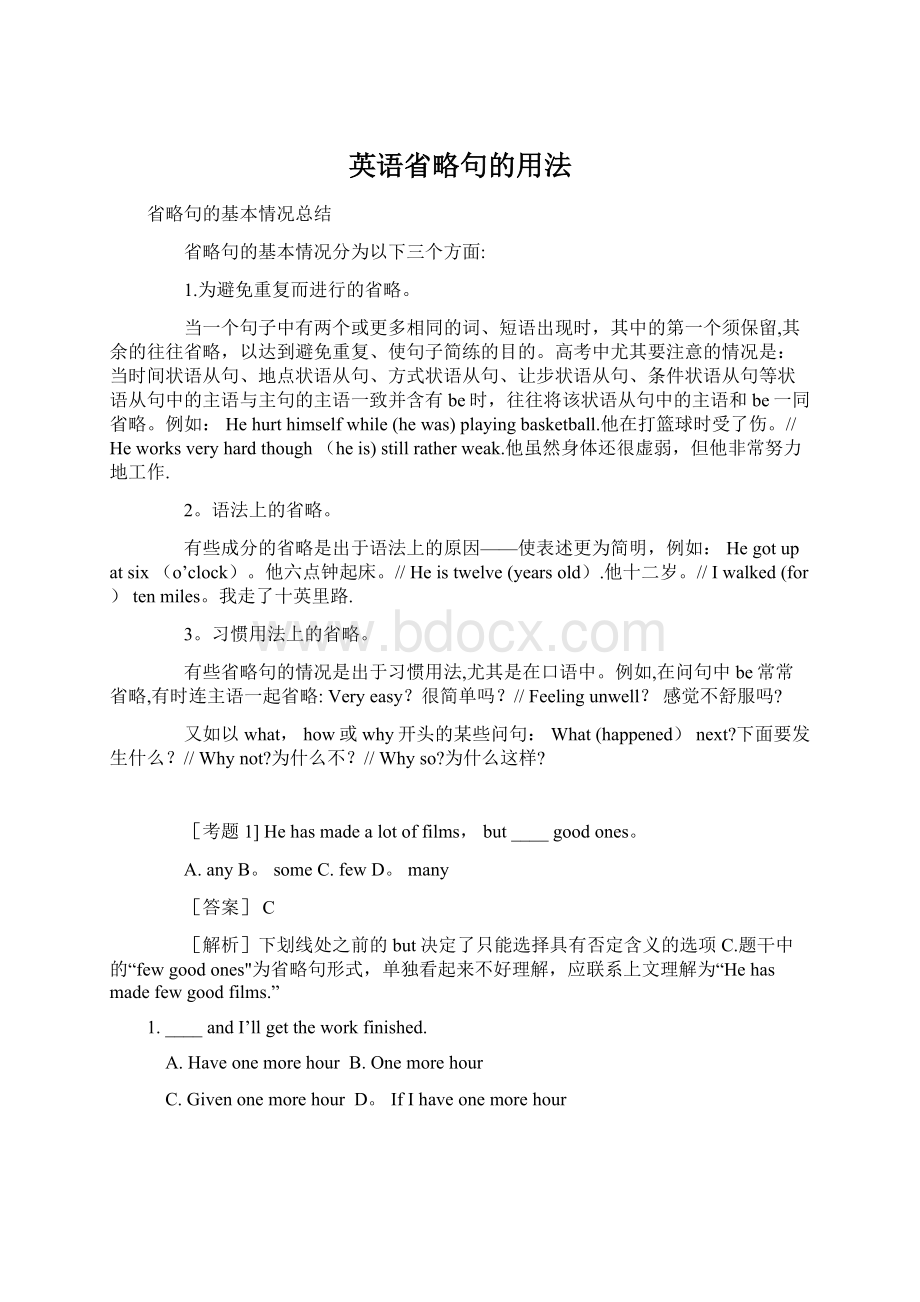英语省略句的用法.docx
《英语省略句的用法.docx》由会员分享,可在线阅读,更多相关《英语省略句的用法.docx(13页珍藏版)》请在冰豆网上搜索。

英语省略句的用法
省略句的基本情况总结
省略句的基本情况分为以下三个方面:
1.为避免重复而进行的省略。
当一个句子中有两个或更多相同的词、短语出现时,其中的第一个须保留,其余的往往省略,以达到避免重复、使句子简练的目的。
高考中尤其要注意的情况是:
当时间状语从句、地点状语从句、方式状语从句、让步状语从句、条件状语从句等状语从句中的主语与主句的主语一致并含有be时,往往将该状语从句中的主语和be一同省略。
例如:
Hehurthimselfwhile(hewas)playingbasketball.他在打篮球时受了伤。
//Heworksveryhardthough(heis)stillratherweak.他虽然身体还很虚弱,但他非常努力地工作.
2。
语法上的省略。
有些成分的省略是出于语法上的原因——使表述更为简明,例如:
Hegotupatsix(o’clock)。
他六点钟起床。
//Heistwelve(yearsold).他十二岁。
//Iwalked(for)tenmiles。
我走了十英里路.
3。
习惯用法上的省略。
有些省略句的情况是出于习惯用法,尤其是在口语中。
例如,在问句中be常常省略,有时连主语一起省略:
Veryeasy?
很简单吗?
//Feelingunwell?
感觉不舒服吗?
又如以what,how或why开头的某些问句:
What(happened)next?
下面要发生什么?
//Whynot?
为什么不?
//Whyso?
为什么这样?
[考题1]Hehasmadealotoffilms,but____goodones。
A.anyB。
someC.fewD。
many
[答案]C
[解析]下划线处之前的but决定了只能选择具有否定含义的选项C.题干中的“fewgoodones"为省略句形式,单独看起来不好理解,应联系上文理解为“Hehasmadefewgoodfilms.”
1.____andI’llgettheworkfinished.
A.HaveonemorehourB.Onemorehour
C.GivenonemorehourD。
IfIhaveonemorehour
[答案]B
[解析]表示时间的名词onemorehour在这里相当于祈使句“Givemeonemorehour。
”,与and后面的陈述句并列,表示时间的名词经常可以以单独出现的省略形式表示一个祈使句的含义。
[考题3]Afterhebecameconscious,heremembered____and____ontheheadwitharod。
A.toattack;hitB。
tobeattacked;tobehit
C.attacking;behitD.havingbeenattacked;hit
[答案]D
[解析]表示他清醒之后回忆起过去发生的情况,应选用动名词的形式而不是不定式的形式,先排除选项A和B;由于主语是被袭击,应表示出被动语态,进一步排除C而选出D。
D选项中的hit前省略了与其并列的宾语当中相同的“havingbeen”。
[考题4]Thepolicefoundthatthehouse____andalotofthings____.
A。
hasbrokeninto;hasbeenstolen
B.hadbrokeninto;hadbeenstolen
C.hasbeenbrokeninto;stolen
D.hadbeenbrokeninto;stolen
[答案]D
[解析]主句谓语动词found后有两个并列的宾语从句,两个宾语从句中的主语thehouse和alotofthings都是物,两个宾语从句中的谓语动词都应采用过去完成时的被动语态形式来表示在警方发现之前已经完成的被动动作,四个选项中前半部分采用了过去完成时的被动语态形式的只有选项D,因此应选D。
本题第二个下划线处采用了stolen的形式,这属于为避免重复而省略的形式,省略了与前一宾语从句相同的成分hadbeen。
2。
Oneofthesidesoftheboardshouldbepaintedyellow,and____。
A.theotheriswhiteB.anotherwhite
C。
theotherwhite D.anotheriswhite
[答案]C
[解析]特指木板的另一侧应使用定冠词the,因此首先要排除表示泛指意义的选项B和D;又因为A选项不能表示出与前面分句一致的被动动作,因此选C.本题下划线处采用了theotherwhite的形式,这属于为避免重复而使用的省略句,其完整形式为“theothersideoftheboardshouldbepaintedwhite”。
3。
Theresearchissodesignedthatonce____nothingcanbedonetochangeit。
A.beginsB。
havingbegunC。
beginningD。
begun
[答案]D
[解析]once后省略了it(指前面刚被提及的theresearch)is,下划线表示一个“(研究)被开始,被启动"的被动动作,应该采用过去分词的形式,因此本题选D。
注意:
本题题干中省略的it(theresearch)is是顺承上文而自然进行的省略,被省略后仍可以很清楚地把握它的意思,而且使得整个句子更为简练。
4。
HespeaksEnglishwellindeed,butofcoursenot____anativespeaker.
A。
asfluentasB.morefluentthan
C。
sofluentlyasD。
muchfluentlythan
[答案]C
[解析]but在本题中作并列连词连接两个分句,后一分句属于省略句,为了避免重复而省略了主句中的主语he和比较状语从句中的谓语speaksEnglish,由此可以看出题干中是在对he和anativespeaker说英语的熟练程度进行比较。
说英语的熟练程度应选用副词fluently,所以首先排除选项A、B;muchfluentlythan中than前面没有出现fluently的比较级的形式,应进一步排除选项D而选出C。
[考题8]Nomatterhowfrequently____,theworksofBeethovenstillattractpeopleallovertheworld。
A。
performedB。
performing
C。
tobeperformedD.beingperformed
[答案]A
[解析]题干中让步状语从句的原型为nomatterhowfrequentlytheyareperformed(无论这些作品是如何经常地被表演),其中的theyare可以省略。
[考题9]Theflowershisfriendgavehimwilldieunless____everyday.
A。
wateredB。
wateringC。
waterD.towater
[答案]A
[解析]条件状语从句的主语是被省略掉的与主句主语相同的theflowers,由于下划线要表示“(花)被浇水"的被动动作,因此只能选表示被动动作的选项A,watered之前可以加上被省略的theyare。
5.—ArethereanyEnglishstorybooksforusstudentsinthelibrary?
—Thereareonlyafew,______.
A.ifanyB.ifthereC。
ifsomeD。
ifhas
6.—Wouldyouliketogowithus?
-Yes,______。
A.I’dB.I’dlikeC。
I’dliketoD。
I'dliketodo
3。
-Wouldyouliketohaveatryonceagain?
—____.
A。
Yes,IlikeB.No,Idon'tlikeit
C.Yes,IwantverymuchD。
Yes,I’dliketo
4。
—WhatdoyouthinkmadeMarysoupset?
-____herbicycle.
A。
AsshelostB.Lost
C。
LosingD.Becauseoflosing
5。
-Whendidtheygetdowntothejob?
—____.
A.UntiltheyleftB。
Tilltheyarrived
C.SincetheyfinisheditD.Notuntiltheyturnedtome
6。
—Areyouangry?
—Yes.Heshouldatleastanswerwhen____。
A。
speakingB。
spokentoC。
spokenD。
speakingto
本章补充强化训练题参考答案
1。
A2。
C3。
D4.C5.A6.B
英语中的省略句
省略句是高考考查的语法重点,又是学习的难点。
在英语中,为了使句子简洁明快,突出重点,常用"省略句”,只要不影响句意的表达,能省略的成分尽可能省略。
省略现象随处可见,大致可分为以下几种情况。
一、简单句成分的省略
1. 省略主语。
如:
Haven't seen you for ages!
好久不见了!
2。
省略谓语。
如:
(Is there) Anything you want?
你要什么东西吗?
(Does) Anybody need help?
有人要帮忙吗?
3。
省略宾语。
如:
I don't know (where he is ). 我不知道。
4。
省略主语和谓语(或谓语的一部分),只剩下表语、宾语、状语或其它成分.如:
(I'm) Afraid I can't come。
恐怕我不能来了。
(Have you) Got any ink?
你有墨水吗?
-It’s a long time since I saw my sister.
-_________her this weekend?
A。
Why not visit B。
Why not to visit C. Why not visiting D. Why don’t visit
解析:
答案为A.本题考察省略结构,这里why not visit =Why didn’t you visit ,这种既注重基础又兼顾生活交际的试题,其实多数学生感觉很容易能得出正确的A答案。
二、复合句的省略
1。
在含有状语从句的复合句中
由when,while,as, once,whenever引导的时间状语从句;或由if,unless引导的条件状语从句;由though,although,even if ,even though引导的让步状语从句;由as though,as if,as引导的方式状语从句;由because引导的原因状语从句;由wherever引导的地点状语从句,若从句的主句是it或与主句的主语相同,且在谓语中含有be时,常省略从句的主语和be。
例如:
When (she was) asked , she didn't answer a word。
当她被问到的时候,她一句话也说不上来。
Water can be changed into vapor if (it is ) heated。
水如果被加热就能变成水蒸气.
When (you are) working,you must pay attention. 当你上班的时候, 你必须全神贯注。
We may try again when (it is) necessary . 当它有必要的时候,我们可以再试一次。
7。
We all know that, __________, the situation will get worse.
A。
not if dealt carefully with B。
if not carefully dealt with
C。
if dealt not carefully with D. not if carefully dealt with
解析:
答案为B.本题考查状语从句的省略问题,即根据本句完整句子应该补充为:
if (it is) not carefully dealt with,当然, 现在的语言中,已经把这种省略形式固定化了即:
if not.
2.在限定性定语从句中
作宾语的关系代词that,which, whom可以省略;在以the same。
。
。
as和such.。
。
as引导的定语从句中,可以省略与主句相同的部分;the way后面的定语从句中,可以省略that,in which。
例如:
All you ever want to do is going shopping. 你所想的就是购物。
Is this the reason he explained at the meeting for his carelessness in his work?
这就是他在会议上为他上班粗心解释的理由吗
What surprised me was not what he said but the way he said it. 使我惊奇的不是他所说的,而是他说话的方式。
-Do you have anything to say for yourselves?
—Yes,there's one point_____ we must insist on。
A.why B.where C.how D./
答案为D。
有一点(point)我们必须要坚持的。
先行词point 在定语从句中作宾语.关系代词that 省略,故答案为D。
3.宾语从句的省略.如:
Tom has gone home, but I don't know why (he has gone home)。
汤姆已经回家了,但是我不知道为什么(他回家)。
I heard (that ) he had gone abroad. 我听说他出国了。
Having checked the doors were closed , and _________ all the lights were off, the boy opened the door to his bedroom.
A。
why B. that C。
when D. where
解析:
答案为B 。
that引导并列的宾语从句,Having前省去that,并列的两个以that引导的宾语从句即使省略第一个that,第二个that 一般不能省.
三、 并列句的省略
在并列句中,如果后面的分句,与前面的分句有相同的部分,这一部分则常被省略掉,以免重复。
如:
He teaches English and his brother maths. 他教英语, 他的哥哥教数学.
We have been waiting for her to come back to see us, but (we have been waiting) in vain. 我们一直在等她回来看望我们,但我们白等了。
He has made a lot of films,but ____ good ones.
A。
any B. some C。
few D。
many
解析:
答案为C。
他制作了很多电影,但是好的很少。
But 引导的并列句子进行了省略but few good ones = but he made few good ones .
四、肯定结构
So+助动词/情态动词+主语句型.这一结构用来表示相同概念,即前面所说的情况也同样适用于另一人或物,意思是“同样"、“也那样",常理解为倒装结构。
如:
The boy died and a week later. So did his sister. 这个男孩死了,一周以后,他的姐姐也死了.
I’m an English teacher, so is my wife. 我是个英语老师,我的妻子也是。
-My room gets very cold at night.
- ___________。
A. So is mine B. So mine is C. So does mine D。
So mine does
解析:
答案为C。
在两个答句中,当两者(人或物)情况或意思完全相同,第二个分句用so引出时,出现省略现象,还可引起倒装结构,表示”也……”。
本句子的意思:
“我的房子晚上很冷".“我的也是”。
So does mine 相当于My room gets very cold at night, too.
注意:
有时可用so代替名词性从句,以避免重复前面所说的内容,可以用于这类结构的动词有think, believe, suppose, expect, imagine, guess, hope等。
肯定回答结构为”主语+动词+so”,否定回答结构为"主语+助动词否定形式+动词+so"或”主语+动词+not"。
但动词为hope, guess时,否定回答只能说hope (guess) not,不能说don’t hope (guess) so.
-It is sunny today。
今天阳光灿烂。
-So it is. (=It's really sunny today。
) 是的。
-Will you be able to finish your respect today?
- 。
A. I like it B。
I hope so C. I’ll do so D。
I’d love it
解析:
答案为B。
考查情景对话。
句意为“希望如此”。
五、在否定结构中
由nor,neither等引导的连续否定的句子也是一种省略句,这种句子在意思上与前面的句子是相同的,而且主谓用倒装。
例如:
-I would never come to this restaurant again. The food is terrible!
我再也不去那家餐馆了。
饭菜太难吃了!
-Neither would I 。
我也不去了。
If Joe' s wife won' t go to the party, _______。
A. he will either B。
neither will he C。
he neither will D。
either he will
解析:
答案为B。
如果Joe的妻子不去舞会的话,Joe也不会去。
neither引导的连续否定的句子也是一种省略句而且主谓用倒装,这里nither he will 相当于he will not go to party , neither 。
六、不定式的省略
1。
在see, watch, hear, feel, observe, notice, look at, listen to等感观动词及使役动词let ,make ,have 后的”宾语+动词不定式作宾语补足语”的结构中,不定式符号to须省略,但这类结构变成被动语态时,其后的不定式要还原加上to。
如:
I haven’t told you that my family made a lot of money in the nineteenth century by making children work 16 hours a day in their factories.
The children were made to work more than 16 hours a day。
-Excuse me sir,where is Room 301?
-Just a minute.I’ll have Bob ____you to your room。
A。
show B。
shows C. to show D. showing
解析:
答案为A。
have sb。
do sth. 结构中,不定式结构to do 省略to 。
故本句的结构应是:
I’ll have Bob show you to your room。
2. 系动词(be)+形容词,即be afraid / ready / glad / happy / willing等后面接不定式时有时为了避免重复,常省略与上文表达相同意思的不定式符号to之后的内容,只保留不定式符号,例如:
-Could you go shopping with me?
-I'm glad to (go shopping with you).
-I’ll be away on a business trip。
Would you mind looking